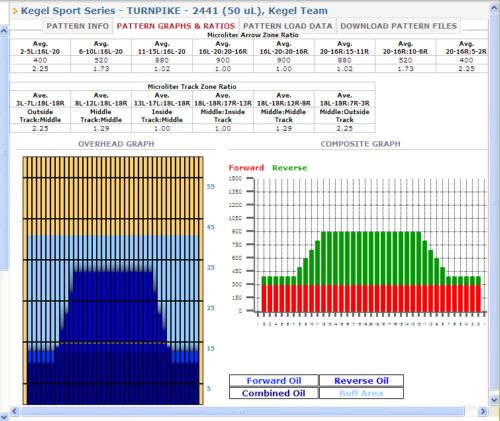Difference between revisions of "How to read an oil pattern graph"
| Line 2: | Line 2: | ||
[[Image:Kegel oil graph.jpg|thumb|right|500px|Kegel Turnpike Example]] | [[Image:Kegel oil graph.jpg|thumb|right|500px|Kegel Turnpike Example]] | ||
| − | First, looking at the blue graph one can see the length of the graph and see that this one is 41 feet. Therefore, you want the ball around 10 at the | + | First, looking at the blue graph one can see the length of the graph and see that this one is 41 feet. Therefore, you want the ball around 10 at the exit point. Next, if you look at the red and green graph you can see the micro-liters used in each section or I prefer to use the top table to get this information. |
<br /><br /> | <br /><br /> | ||
If you multiply the last and first numbers in the chart by 4 and all the others in between by 5 and add all of these up and it will tell you the total # of micro liter on the lane. Then, divide by 1000 and there is your mils on the lane.<br /><br /> | If you multiply the last and first numbers in the chart by 4 and all the others in between by 5 and add all of these up and it will tell you the total # of micro liter on the lane. Then, divide by 1000 and there is your mils on the lane.<br /><br /> | ||
Revision as of 22:10, 28 October 2010
This guide is a basic introduction on how to read a oil pattern graph.
First, looking at the blue graph one can see the length of the graph and see that this one is 41 feet. Therefore, you want the ball around 10 at the exit point. Next, if you look at the red and green graph you can see the micro-liters used in each section or I prefer to use the top table to get this information.
If you multiply the last and first numbers in the chart by 4 and all the others in between by 5 and add all of these up and it will tell you the total # of micro liter on the lane. Then, divide by 1000 and there is your mils on the lane.
Example from chart:
(400*4 + 520*5 + 880*5 + 900*5 + 900*5 + 880*5 + 520*5 + 400*5)/1000 = 26.2
This is fairly high volume. Thus, Im going to use an aggresive ball and I do not expect the lanes to change real fast.
Last, thing to look at is the ratio. This pattern is 2.25 to 1. Meaning there is 2.25 the amount of oil in the middle on the outside. This pattern is going to be fairly tough but playable. As the track blows up to the right if you have the right ball in your hand you should be able to move your feet left and throw to the track using the inside oil for a little room in the middle.
I hope this helps. Again there are other factors such as Topography of the Lanes and Lane Surface that matters also. Since those were not the questions I will not go into them right now, but if you have questions about them post it.
~Old_Hickory
